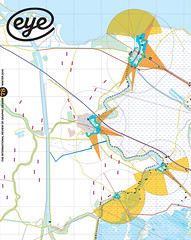Winter 2010
Joyously tasteless art direction
Drunk Stoned Brilliant Dead: The Writers and Artists Who Made the National Lampoon Insanely Great
By Rick Meyerowitz. Designed by Laura Lindgren, Abrams, New York, $40, £24.99Allow me to get something off my chest. Of the two jobs I once most coveted in the world, one was art director of the National Lampoon. I got the other one, at The New York Times, but I was never even shortlisted for the Lampoon and it bugs me to this day. So, when Rick Meyerowitz (incidentally, the first illustrator to whom I assigned a professional job in the late 1960s) invited me to write a brief essay for his book about the magazine, I jumped at the opportunity to open my wounds after almost 40 years. But it was not meant to be. Over lunch one day, Meyerowitz casually said that my essay was edited out (‘thrown into the trash’ were his exact words). He paid the cheque.
Now that the book is out, I cannot say it is worse for not including my words. In fact, I can say that it is an insanely great account of America’s premiere humour magazine during its golden years. Smartly and wittily written (as it should be) and beautifully designed by Laura Lindgren, Drunk Stoned Brilliant Dead is as entertaining as it is solid first-hand reflection and history.
If, as the late Michael O’Donoghue, a founding Lampooner, said, ‘making people laugh is the lowest form of humour’, I am happy to wallow in the depths. For every joyously tasteless, anti-establishment component of the Lampoon made me, as a young reader, rise above the frustrations of American life during the Nixon-Vietnam War era. Robert Grossman’s August 1972 Nixon-as-Pinocchio gatefold cover (with extending nose) gave me hope in the Watergate days that political satire was alive and punitive. In fact, as I flip through the book, it is amazing how many (89.5 per cent) of the contents I vividly recall.
What I did not recall, however, was all the inside dish I was not privy to because I was never on staff. The inner workings are brilliantly recalled in Meyerowitz’s text and the written contributions of successful former Lampooners, Tony Hendra, P. J. (Pat) O’Rourke, Emily Prager, Christopher Cerf, M. K. Brown, Shary Flenniken (one of the pioneering women underground comix artists) and more.
Then there are the classic parodies. I recall my high-pitched squeal (or gasp) when I saw the take-off of Volkswagen’s 1960s ‘Think small’ campaign: ‘If Ted Kennedy drove a Volkswagen, he’d be President today’ showed a VW Beetle floating in water, an irreverent reference to the tragic drowning of Mary Jo Kopechne (which indeed was blamed on Kennedy and cost him the United States presidency). I still am amazed by the spot-on exactitude of ‘Stranger in Paradise’ by Michel Choquette with Anne Beatts, a photographic travelogue following a perfect doppelganger for Adolf Hitler and his faithful indigenous companion, Freitag, on a South Sea island beach. And of ‘Barbar [sic] and His Enemies’ by Sean Kelly and Tony Hendra, illustrated by Peter Kleinman, in which the monkeys take revenge on imperialist elephants – it still has political resonance.
There are few things more memorable than Lampoon’s covers, and Meyerowitz, who illustrated a few, including ‘The Mona Gorilla’, devotes chapters to its various art directors and their wares. Michael Gross was responsible for some of the consistently memorable, including ‘If You Don’t Buy This Magazine, We’ll Kill This Dog’ with a photo of a nervous pooch with a gun to his head (the ‘Death’ issue, January 1973); the portrait of Che Guevara with a pie thrown in his face for ‘Is Nothing Sacred?’ (January 1972); and the partly eaten chocolate child beggar for the ‘Dessert’ issue (July 1974). And who of a certain age can forget the cover of the National Lampoon 1964 High School Yearbook (1974), the work of P. J. O’Rourke and Doug Kenney, art-directed by David Kaestle with Vince Aiosa, and featuring skirt-twirling cheerleaders, with one showing her perfectly airbrushed, blemish-free naked behind?
Launched in 1970, the Lampoon was the wellspring of American written and visual humour. If it didn’t exist there could be no Animal House, no Saturday Night Live (Lampoon alumni had everything to do with both), no Spy magazine, and definitely no Jon Stewart or Stephen Colbert. So thanks to the Lampoon’s crew for altering the course of wit and satire. Thanks to Rick Meyerowitz for reprising the work and writing the history. And thanks to whomever did not put me on the short-list for art director. I probably wouldn’t have been that good anyway.
First published in Eye no. 78 vol. 20 2010
Eye is the world’s most beautiful and collectable graphic design journal, published quarterly for professional designers, students and anyone interested in critical, informed writing about graphic design and visual culture. It is available from all good design bookshops and online at the Eye shop, where you can buy subscriptions and single issues.

